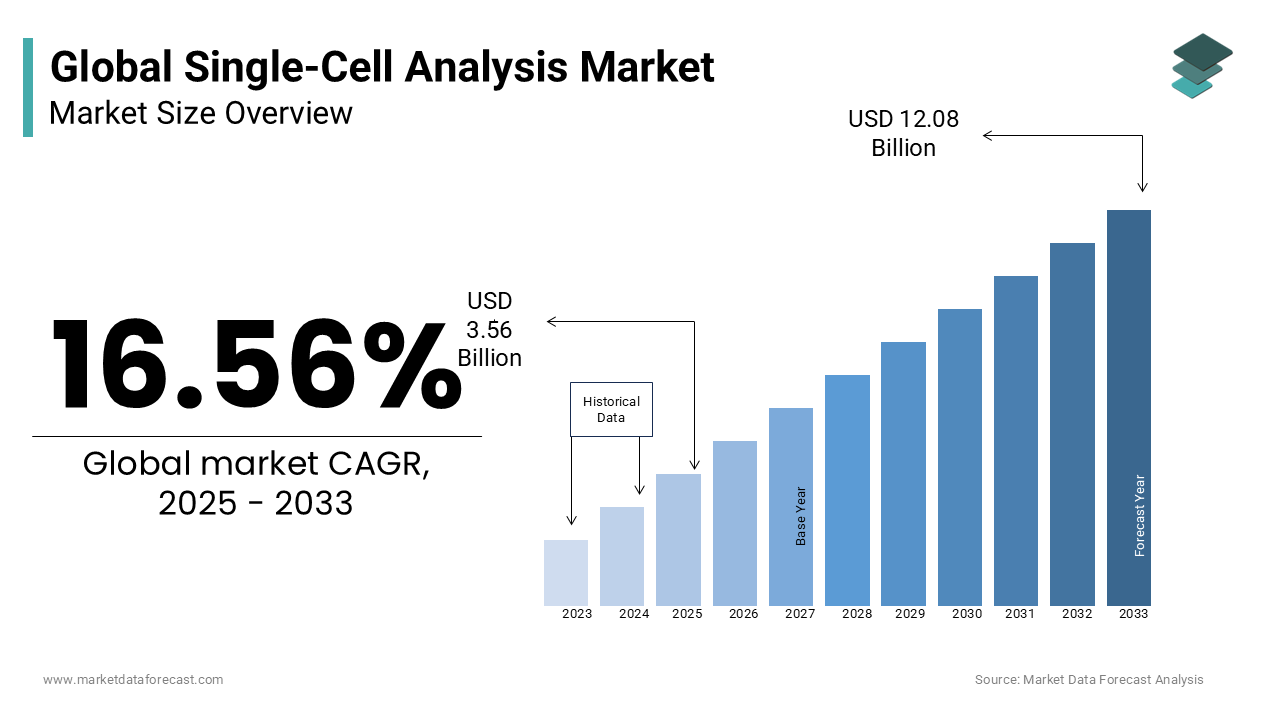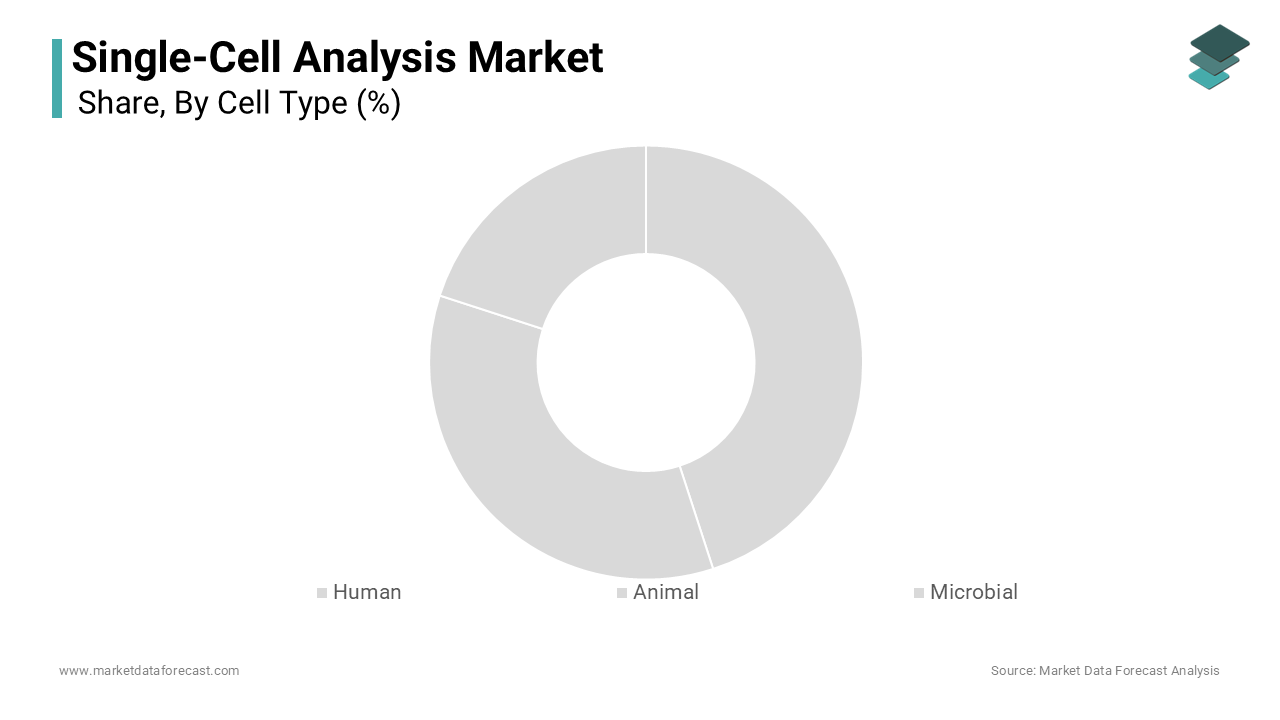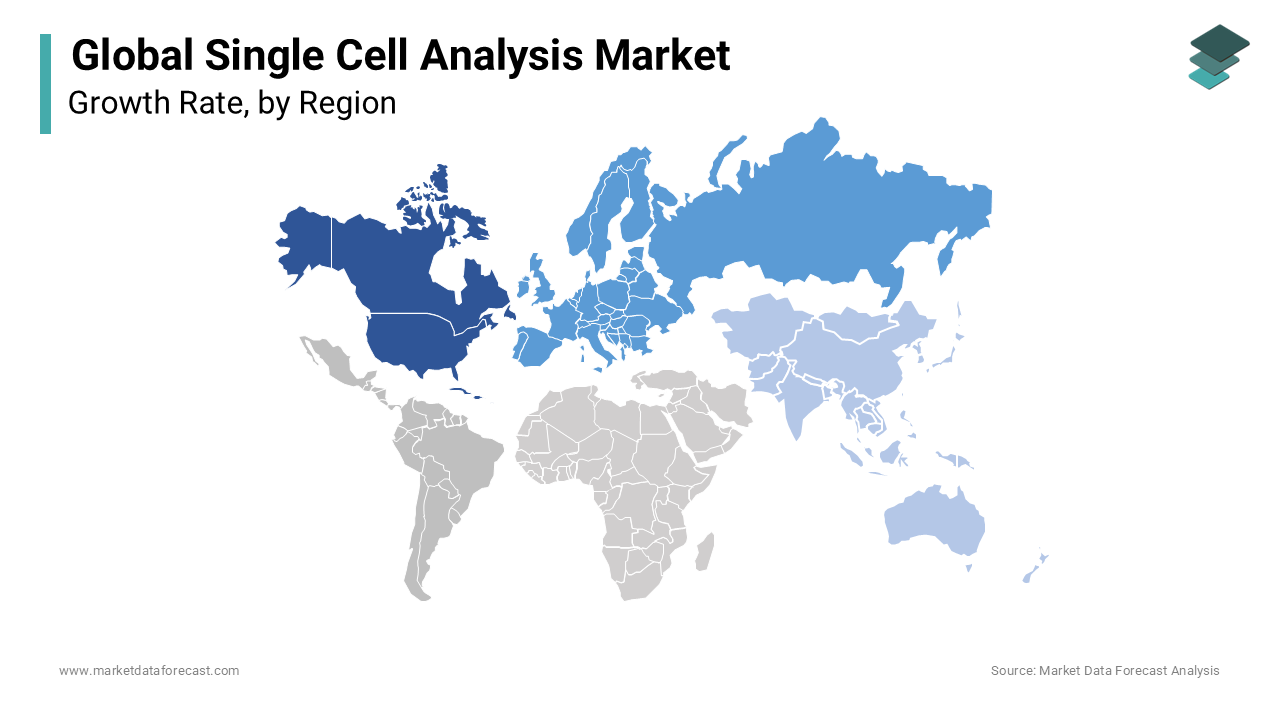Global Single-Cell Analysis Market Size, Share, Trends & Growth Analysis Report – Segmented By Cells (Human Cells, Animal Cells and Microbial Cells), Products, Technique (Flow Cytometry, Next-generation Sequencing, Polymerase Chain Reaction (PCR), Microscopy, Mass Spectrometry and Other Techniques), Application and Region – Industry Analysis From 2025 to 2033
Global Single-Cell Analysis Market Size
As per our report, the global single-cell analysis market size was valued at USD 3.06 billion in 2024. The market size is estimated to be worth USD 12.08 billion by 2033 and USD 3.56 billion in 2025, growing at a CAGR of 16.5% during the forecast period.

MARKET DRIVERS
The growing aging population is one of the major factors propelling the single-cell analysis market growth.
The aging population is growing rapidly worldwide. As per the statistics published by World Health Organization (WHO), the number of people above the age of 60 is expected to reach 1.4 billion in 2030 and 2.1 billion by 2050. The single-cell analysis has gained significant importance in recent years. Several healthcare has realized the potential of single-cell analysis to advance their understanding of age-related diseases such as cancer, Alzheimer's disease, Parkinson's disease and cardiovascular diseases. The researchers have been using single-cell analysis to identify disease-specific cell populations, characterize their functional properties, and develop targeted therapies. The growing aging population is also fuelling the adoption of personalized and precision medicine approaches and single-cell analysis plays a vital role in the development of such approaches. The single-cell analysis is used to understand inter-individual cellular variability and tailor treatments accordingly. Likewise, the single-cell analysis helps by offering useful insights into cellular heterogeneity, disease mechanisms and personalized treatment strategies to address the healthcare challenges associated with aging and age-related diseases.
The rising prevalence of infectious diseases and the increasing preference for precision medicine further boost the growth rate of the single-cell analysis market. Infectious diseases have become a significant health challenge worldwide. People have been constantly suffering from new and re-emerging infectious agents emerging. The techniques of single-cell analysis are used to study the interactions between pathogens and host cells at a single-cell resolution and analyze individual immune cells. The researchers use the data resulting from the analysis of single-cell analysis to understand the immune response to infections and develop more effective vaccines. On the other hand, the adoption of precision medicine is on the rise worldwide. Healthcare organizations have been increasingly using the precision medicine approach considering the unique genetic, environmental and lifestyle characteristics. The single-cell analysis is used in precision medicine approaches to study cellular heterogeneity and individual variations in disease progression and response to therapies. The adoption and preference of precision medicine are likely to fuel in the coming years. They are estimated to boost the demand for advanced tools like single-cell analysis that play a necessary role in the development of personalized therapeutic interventions.
As the health problems worldwide continue to rise, the need for research to develop better and more effective medicines also increases. Along with the technological advancements in single-cell analysis products, it is expected to drive the market forward. The growing number of single-cell analysis applications such as genomics, transcriptomics, proteomics and epigenetic studies further boosts the market growth. Similarly, big players are investing in R&D to evaluate single-cell analysis applications in stem cell transplant procedures to improve these processes' success rates. Furthermore, the advent of advanced devices that allow secure procedures for transcriptomics and proteomics causes the adoption of single-cell analysis techniques. Over the forecast period, government marketing schemes and measures such as Health Japan 21 and Germany's Preventive Health Care Act are expected to fuel market growth. Factors such as the high prevalence of neurological disorders and the increase in disease incidence drive market growth.
MARKET RESTRAINTS
Factors significantly hindering the growth of the global single-cell analysis market are the high costs associated, restricted healthcare reimbursement policies, and concerns related to intellectual property rights. Moreover, growing competition for new entries into the market obstructs the single-cell analysis market growth during the forecast period.
REPORT COVERAGE
|
REPORT METRIC |
DETAILS |
|
Market Size Available |
2024 to 2033 |
|
Base Year |
2024 |
|
Forecast Period |
2025 to 2033 |
|
Segments Covered |
By Cell Type, Technique, Application, End-User, and Region |
|
Various Analyses Covered |
Global, Regional & Country Level Analysis, Segment-Level Analysis, Drivers, Restraints, Opportunities, Challenges; PESTLE Analysis; Porter’s Five Forces Analysis; Competitive Landscape; Analyst Overview of Investment Opportunities |
|
Regions Covered |
North America, Europe, Asia Pacific, Latin America, the Middle East, and Africa |
|
Market Leaders Profiled |
Merck KGaA, Becton, Dickinson and Company, Promega Corporation, Danaher Corporation, General ElectricCompany, Thermo Fisher Scientific, Miltenyi Biotec, Illumina, Bio-Rad Laboratories, Fluidigm Corporation, NanoString Technologies, Agilent Technologies, Abcam Plc. |
SEGMENTAL ANALYSIS
By Cell Type Insights

Based on cell type, the human cells segment had the largest share of the global single-cell analysis market in 2024. The domination of the segment is likely to continue during the forecast period owing to the rising prevalence of infectious diseases in the geriatric population and stem cell research funding. The growing patient population suffering from chronic diseases, such as cancer and autoimmune disorders and rapid adoption of precision medicine approaches further contribute to the segmental growth.
The microbial segment is predicted to witness a promising CAGR during the forecast period owing to the growing need to study the microbial communities in healthcare, agriculture and environmental science and the rising demand for precision microbiome analysis.
The animal segment is expected to grow at a healthy CAGR during the forecast period due to the growing use of animal models in drug discovery and development and increasing investments by pharmaceutical companies in animal-based research.
By Technique Insights
Based on technique, the flow cytometry segment had the major share of the global market in 2024 and is expected to lead the market during the forecast period. The growing usage of flow cytometry in identifying and measuring the physical and chemical characteristics of the population of cells or particles is one of the key factors propelling segmental growth. The versatility and widespread of flow cytometry are driving the adoption of this technique in research, clinical diagnostics and drug development and this trend is expected to accelerate in the coming years and boost the segment’s growth rate. The growing demand for studying cellular heterogeneity, immune profiling, and rare cell detection further contributes to segmental growth.
On the other hand, the NGS segment is anticipated to have the highest CAGR during the forecast period owing to the increasing applications among the products in drug discovery for cancer and other constant and continuous diseases. NGS is a high-throughput, sensitive, and cost-effective method for analyzing thousands to millions of individual cells simultaneously, which is one of the major factors driving segmental growth. The rising demand for understanding complex biological processes, disease mechanisms and personalized medicine further fuels the growth rate of the segment.
By Application Insights
Based on the application, the research applications segment held the leading share of the global market in 2024 and is likely to continue the leading trend during the forecast period. Scientists continue to uncover the complexities of biological systems at the single-cell level and this trend is likely to continue in the coming years and drive the segmental growth. The rising demand for advancements in disease understanding, drug discovery, and the development of novel therapies further promotes segmental growth.
The medical applications segment accounted for a considerable share of the global market in 2024 and is predicted to grow at a healthy CAGR during the forecast period. The rising demand for precision medicine, improved diagnostic approaches and advancements in disease understanding drive the segmental growth.
By End User Insights
Based on the end-user, the hospitals and diagnostic laboratories segment is expected to dominate the market during the forecast period due to continuous efforts to cover the gap in implementing OMICs technology from the research laboratories to clinical settings. In addition, these hospitals provide high-quality diagnostic care and a safe environment for patients.
REGIONAL ANALYSIS

Geographically, the global market was dominated by the North American single-cell analysis market in 2024, with the region accounting for 37% of the overall market share. North America will dominate the global single-cell analysis market over the forecast period. The well-established healthcare infrastructure and a robust research ecosystem that fosters innovation and adoption of advanced technologies are majorly driving the North American market growth. The presence of leading biotechnology and pharmaceutical companies, academic institutions, and research centers and rising prevalence of chronic diseases, such as cancer, and the focus on precision medicine in the region further boost the growth rate of the North American market. The U.S. led the market in the North American region in 2024 and is expected to repeat the same trend during the forecast period.
The single-cell analysis market in Europe had the second-largest share of the global market in 2024 and is expected to account for a substantial share of the global market during the forecast period, witnessing a prominent CAGR. The strong emphasis on healthcare research and development is making the European region a hub for scientific advancements. The rising geriatric population and increasing incidence of chronic diseases primarily boost the growth of the European single-cell analysis market. The presence of well-established healthcare systems, government initiatives to support research and innovation and an increasing number of collaborations between academic institutions and industry players further contribute to the European market growth. The UK, Germany and France controlled the major share of the European market in 2024.
The single-cell analysis market in APAC is expected to witness the fastest CAGR among all the regions in the worldwide market during the forecast period. The growing investments for the development of healthcare infrastructure, growing population and increasing investments in research and development majorly fuel the growth rate of the APAC market. The growing prevalence of chronic diseases, such as cancer, and the increasing demand for personalized medicine further promote regional market growth. APAC countries such as China, Japan, South Korea, and India are actively investing in biotechnology and genomics research, which favors the regional market’s growth rate during the forecast period.
During the forecast period, the Latin American single-cell analysis market is anticipated to grow at a steady CAGR. The growth of the regional market is driven by the growing number of proteins produced and the development of cell lines. Brazil is expected to have the largest share of the market due to growing healthcare expenditure and an increasing patient population.
The single-cell analysis market in MEA is considered to have a slight inclination in the growth rate due to the development of advanced therapies for cancer treatment.
KEY MARKET PLAYERS
Some of the prominent companies leading the global single-cell analysis market profiled in the report are Merck KGaA, Becton, Dickinson and Company, Promega Corporation, Danaher Corporation, General ElectricCompany, Thermo Fisher Scientific, Miltenyi Biotec, Illumina, Bio-Rad Laboratories, Fluidigm Corporation, NanoString Technologies, Agilent Technologies, Abcam Plc, NuGEN Technologies Inc., LumaCyte, PluriSelect Life Science UG & Co. KG, Sysmex Partec, Bio-Techne Corporation, Promega Corporation, 10x Genomics, WaferGen Bio-systems, Bruker, and Fluxion Bioscience.
RECENT MARKET HAPPENINGS
- In July 2020, 10X Genomics launched its chromium single-cell immunity profiling V2 product. This new product enlarges the initial version's abilities, assisting fundamental breakthroughs in immunology, oncology, autoimmunity, inflammation, and infectious diseases. In addition, the V2 product offers a thorough approach to concurrently testing the cellular heterogeneity of the immune system T and B cells.
- In April 2020, Bio-Rad Laboratories announced that it had obtained Celsee Inc., which provides a scalable, practical, and efficient approach to identifying single cells. In addition, the system can layer thousands to millions of cells for genomic and proteomic applications.
- In June 2019, Beckman Coulter Life Sciences made a public statement regarding the obtainment of Cytobank, a single-cell data analysis. The Cytobank platform boosts research manufacturing by allowing structured high-dimensional data analysis and collaboration across the globe.
MARKET SEGMENTATION
This research report on the global single-cell analysis market has been segmented based on the cell type, technique, application, end-user, and region.
By Cell Type
- Human
- Animal
- Microbial
By Technique
- Flow Cytometry
- Next-generation Sequencing
- Polymerase Chain Reaction (PCR)
- Microscopy
- Mass Spectrometry
- Other Techniques
By Application
- Research Applications
- Cancer Research
- Immunology Research
- Neurology Research
- Stem Cell Research
- Other Research Applications
- Medical Application
- Non-invasive Prenatal Diagnosis
- In Vitro Fertilization
- Circulating Tumor Cell Detection
By End User
- Academic and Research Laboratories
- Biotechnology and Pharmaceutical Companies
- Hospital and Diagnostic Laboratories
By Region
- North America
- Europe
- Asia Pacific
- Latin America
- The Middle East and Africa
Frequently Asked Questions
How much was the global single-cell analysis market worth in 2024?
The global single-cell analysis market was valued at USD 3.06 billion in 2024.
Which segment by cell type led the single-cell analysis market in 2024?
Based on the cell type, the human cell segment accounted for the leading share of the market in 2024.
Which region is anticipated to grow fastest in the global single-cell analysis market?
Geographically, the Asia-Pacific region is predicted to grow the fastest in the global market during the forecast period.
Who are the leading players in the single-cell analysis market?
Merck KGaA, Becton, Dickinson and Company, Promega Corporation, Danaher Corporation, General Electric Company, Thermo Fisher Scientific, Miltenyi Biotec, Illumina, Bio-Rad Laboratories, Fluidigm Corporation, NanoString Technologies, Agilent Technologies, Abcam Plc, NuGEN Technologies Inc., LumaCyte, PluriSelect Life Science UG & Co. KG, Sysmex Partec, Bio-Techne Corporation, Promega Corporation, 10x Genomics, WaferGen Bio-systems, Bruker, and Fluxion Bioscience are the notable players in the market.
Related Reports
Access the study in MULTIPLE FORMATS
Purchase options starting from
$ 2500
Didn’t find what you’re looking for?
TALK TO OUR ANALYST TEAM
Need something within your budget?
NO WORRIES! WE GOT YOU COVERED!
Call us on: +1 888 702 9696 (U.S Toll Free)
Write to us: sales@marketdataforecast.com
